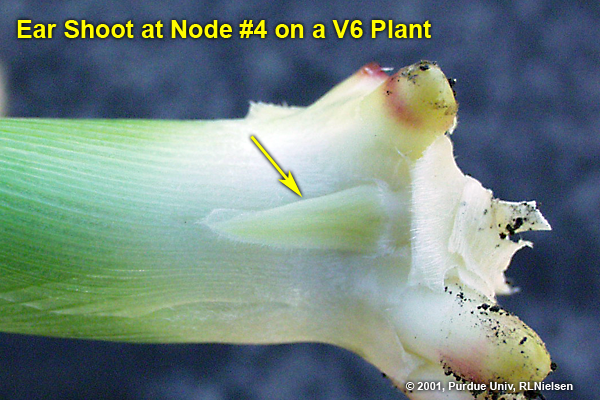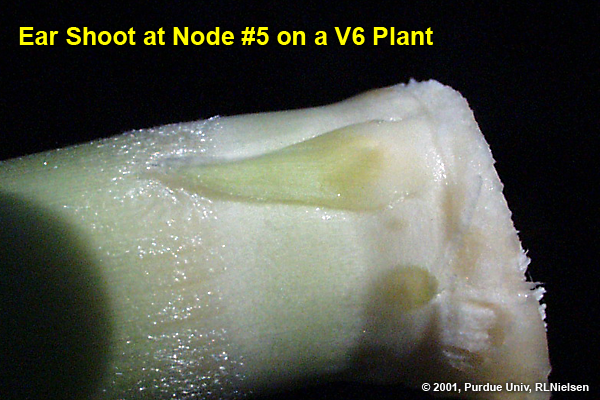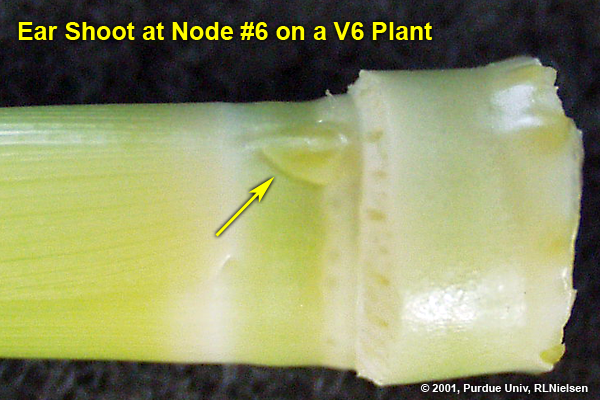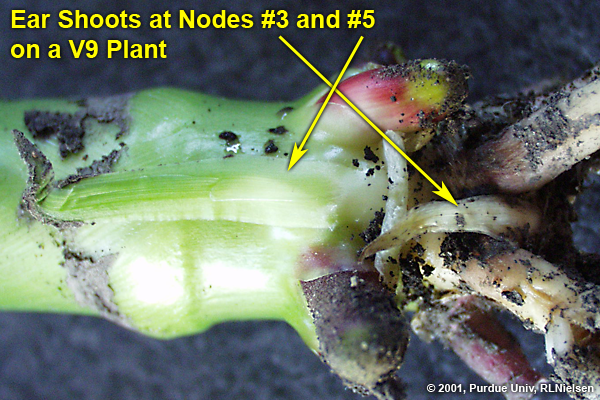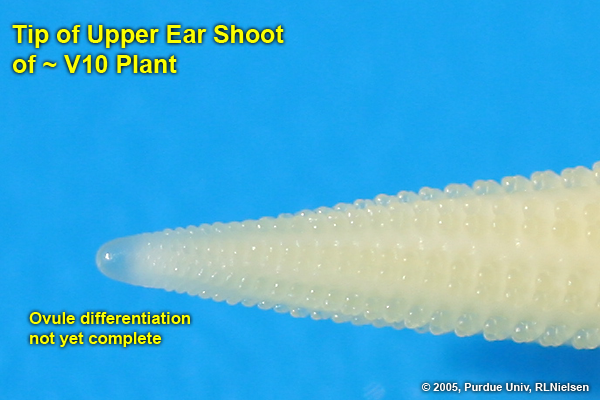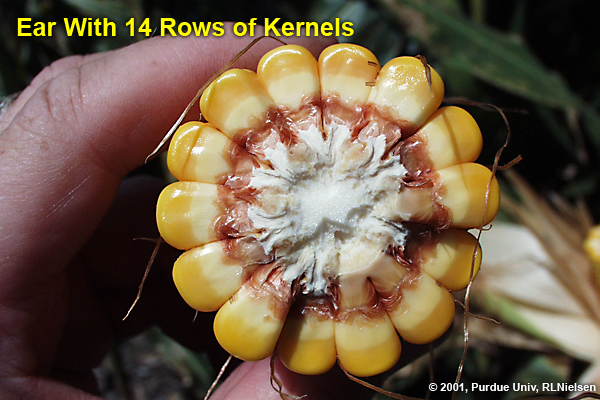June 2023
URL: http://www.kingcorn.org/news/timeless/EarSize.html
Ear Size Determination in Corn
R.L. (Bob) Nielsen
Professor Emeritus
Agronomy Dept., Purdue Univ.
West Lafayette, IN 47907-2054
Email address: rnielsen at purdue.edu
Twitter: @PurdueCornGuy
- Ear shoots are initiated at multiple stalk nodes very early in a corn plant’s development.
- Ear size determination of the uppermost (harvestable) ear begins by the time a corn plant has reached knee-high and finishes 10 to 14 days prior to silk emergence.
![]() he number of harvestable kernels per ear is an important contributor to the grain yield
he number of harvestable kernels per ear is an important contributor to the grain yield  potential of a corn plant. Severe plant stress during ear formation may limit the potential number of kernels, and thus grain yield potential, before pollination has even occurred. Optimum growing conditions set the stage for maximum ear size potential and exceptional grain yields at harvest time. Ear size determination for the uppermost ear shoot of the plant begins shortly after it is initiated at about leaf stage V5 (five leaves with visible leaf collars) and finishes at V12 to V15 (about 10 to 14 days prior to silk emergence).
potential of a corn plant. Severe plant stress during ear formation may limit the potential number of kernels, and thus grain yield potential, before pollination has even occurred. Optimum growing conditions set the stage for maximum ear size potential and exceptional grain yields at harvest time. Ear size determination for the uppermost ear shoot of the plant begins shortly after it is initiated at about leaf stage V5 (five leaves with visible leaf collars) and finishes at V12 to V15 (about 10 to 14 days prior to silk emergence).
Ear Shoot Development
An axillary meristem forms behind the leaf sheath at each stalk node beginning at the base of the stalk and continuing toward the top (acropetally for you wordsmith fans) except for the upper six to eight nodes of the plant. These meristems replicate the activity of the primary apical meristem of the plant by initiating leaf primordia (husk leaves) and a reproductive structure at the distal tip of the ear shank, i.e., the ear shoot (similar in concept to the tassel at the tip of the main stalk).
By about leaf stage V5 or V6, the main growing point of the corn plant (apical meristem) finishes the task of initiating leaf primordia and completes its developmental responsibilities by initiating the tassel primordium of the plant. At about the same time that the tassel is initiated, the uppermost and final ear shoot is also initiated (Lejeune and Bernier, 1996). For hybrids commonly grown in Indiana, this uppermost ear shoot is located at the 12th to 14th stalk node, corresponding to the 12th to 14th leaf of the plant and will become the ear that is harvested.
Careful removal of each leaf from a stalk, including leaf sheaths, at about leaf stage V10 will usually reveal 8 to 10 identifiable ear shoots. As mentioned earlier, each ear shoot originates from an axillary meristem at a stalk node, behind its respective leaf sheath. At leaf stage V10, these tiny ear shoots consist primarily of husk leaf tissue. The developing ears themselves are only a fraction of an inch in length.
Initially, the ear shoots found at the lower stalk nodes are longer than the ones at the upper stalk nodes simply because the lower ones were initiated earlier and so are physiologically older than the upper ear shoots. As time marches on, the upper one or two ear shoots overtake the lower ones, partly because of hormonal “checks and balances” and partly because the upper ear or two are simply closer to the actively photosynthesizing leaves of the upper canopy.
Ear Size Determination
Row number and kernel number per row are two important yield components in corn. For hybrids commonly grown in Indiana, ovule (potential kernel) row number ranges from about 12 to 22, but most commonly 14 to 18. Number of ovules per row ranges from about 50 to 60. Total number of ovules ranges from about 750 to 1000 per ear. Actual (harvestable) kernel number per ear averages between 400 and 600. For a 16-row ear, one kernel per row is equal to about five bushels per acre at average plant populations.
Ovule row number determination on the uppermost ear occurs very quickly after that ear shoot is initiated (V5 to V7 depending on hybrid) (Abendroth et al., 2011; Strachan, 2016). Once row number has been determined, there will never be more rows that develop. The remainder of the "ear size determination" period is comprised of initiating more ovules per row.
Rows of ovules first initiate as single “ridges” of cells that eventually differentiate into pairs of cells (Postlethwait & Nelson, 1964; Strachan, 2016). Thus, row number on ears of corn is always even unless severe stress disrupts the developmental process. True row number is often difficult to visualize without a microscope in tiny ears dissected from plants younger than about the 12-leaf stage.
Row number is determined strongly by plant genetics and less so by environment. This means that row number for any given hybrid will be quite similar from year to year, regardless of growing conditions. In order for stress to affect row number determination, the stress must reduce photosynthesis severely and suddenly immediately after the ear initiates (V5 to V7 depending on hybrid). Examples of such stress include torrential rainfall and sudden flooded soil conditions, sudden defoliation by hail, sudden defoliation by frost event, and sudden changes in temperature (extreme hot to cold, cold to hot). The strong genetic regulation plus the narrow timeframe of susceptibility (V5 to V7) limits the likelihood of restricted row numbers due to stress.
In contrast, ovule number per row is determined over a longer time period, beginning at V5 to V7 (depending on hybrid) for the uppermost primary ear and ending as early as V12 but at least by V15 (Abendroth et al., 2011; Strachan, 2016). Like so many other processes in the corn plant, ovules develop acropetally on the ear shoot, from base to tip. Ovule number per row (ear length) is not regulated as much by the hybrid's genetics as is row number. The fact that severe stress during the vegetative period more frequently reduces ovule number per row than ovule row number is partly due to the longer time period for determining ovule number per row. In other words, there is simply more time for the crop to experience severe stress. This means that potential ear length can vary dramatically year to year as growing conditions vary. As with row number determination, the effect of severe stress on ovule development per row depends on the suddenness and severity of the reduction in available photosynthate. Interestingly, the prolonged stress caused by extremely high plant populations or extremely low soil nitrogen levels causes surprisingly low reductions in ovules per row (R. Nielsen & J. Camberato, Purdue Univ., unpublished data).
Final Comments
Because the initiation of the uppermost (harvestable) ear shoot does not occur until V5 to V7, stress prior to this leaf stage has no direct bearing on ear size determination UNLESS that stress results in a severely stunted or weakened plant. This is particularly true for stress events that damage only the above ground portion of young seedlings without damage to the plants’ growing point regions. Such damaged plants usually can recover well with little evidence of the damage some weeks down the road.
Severe stress from about V5 to V12 that severely limits photosynthesis can directly interfere with ear size determination and result in fewer ovule rows (less likely) or fewer ovules per row (more likely). While a reduction in ovule number can be important, recognize that severe stress occurring during or shortly after pollination has a far greater potential to affect ACTUAL kernels per ear and, thus, grain yield at harvest (Nielsen, 2018; Nielsen, 2020).
Related References
Abendroth, L.J., R.W Elmore, M.J. Boyer, and S.K. Marlay. 2011. Corn Growth and Development. Iowa State Univ. Extension Publication #PMR-1009. https://store.extension.iastate.edu/Product/Corn-Growth-and-Development [URL accessed June 2023].
Bonnett, O.T. 1966. Inflorescences of Maize, Wheat, Rye, Barley, and Oats: Their Initiation and Development. Bulletin 721. Univ. of Illinois, College of Ag., Agricultural Expt. Sta.
Lejeune, P. and G. Bernier. 1996. Effect of environment on the early steps of ear initiation in maze (Zea mays L.). Plant, Cell and Environment, 19:217-224.
Nielsen, RL (Bob). 2018. Effects of Severe Stress During Grain Filling in Corn. Corny News Network, Purdue Univ. Agronomy Extension. http://www.kingcorn.org/news/timeless/GrainFillStress.html [URL accessed June 2023]
Nielsen, RL (Bob). 2020. Kernel Set Scuttlebutt. Corny News Network, Purdue Univ. Agronomy Extension. http://www.kingcorn.org/news/timeless/KernelSet.html [URL accessed June 2023]
Postlethwait, S. N. and O. E. Nelson. 1964. Characterization of Development in Maize Through the Use of Mutants. I. The Polytypic (Pt) and Ramosa-1 (ra1) Mutants. Amer. J. Bot. 51(3):238-243.
Strachan, Stephen D. 2016. Corn Grain Yield in Relation to Stress During Ear Development. DuPont Pioneer Agronomy Sciences, Crop Insights Vol. 26, No. 9 https://www.pioneer.com/CMRoot/Pioneer/US/Non_Searchable/programs_services/earn-the-right/Corn-Yield-Stress-Ear-Development.pdf [URL accessed June 2023]
Click image to view larger version in a popup window. Left or right arrow on your keypad will cycle through the popup images.
